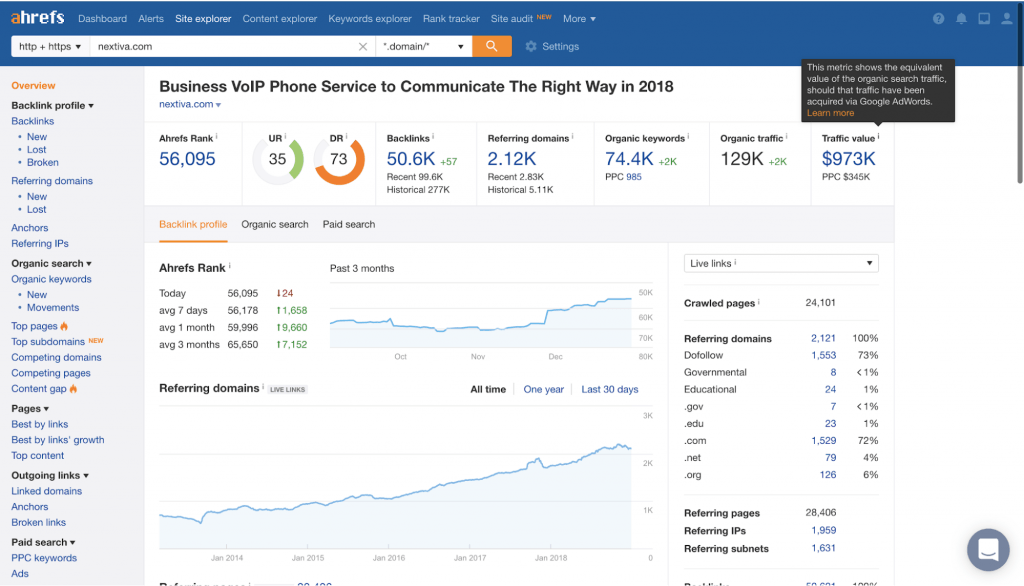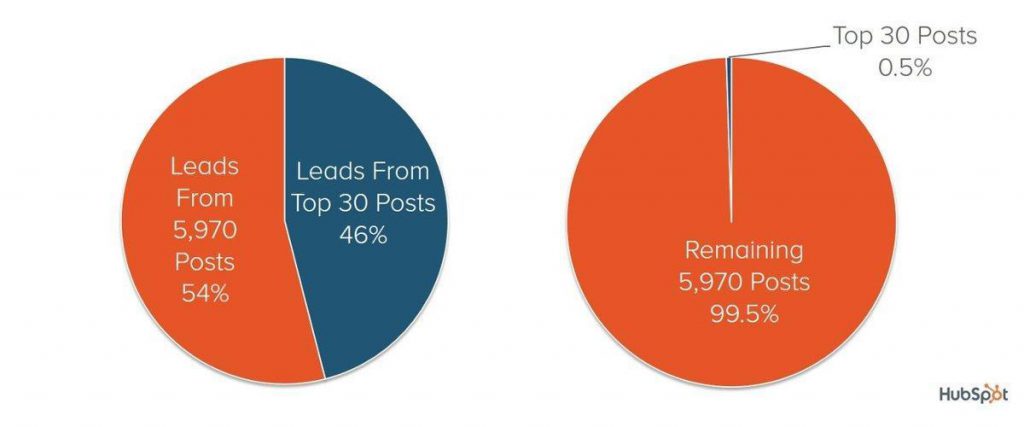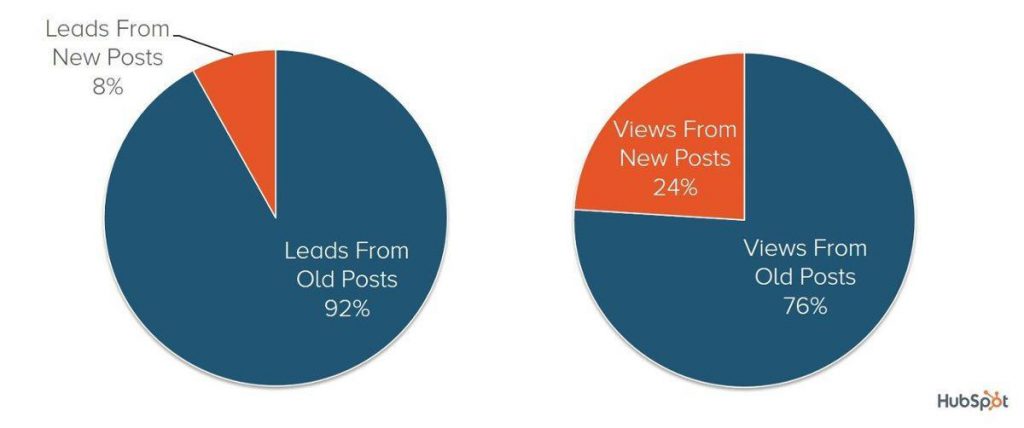SEO traffic is the gift that keeps on giving. Publishing content that gets you to the top of Google and other search engines is one of the best ways to build your business. However, many people misunderstand the right way to get more SEO traffic and fall into bad habits like keyword stuffing.
In this post, you are about to learn the easiest way to get more SEO traffic – using your existing content. Here’s a deep dive into our proven framework for updating, refreshing and republishing old content.
The One Hack to Get More SEO Traffic
Google loves new content. Conduct a search of keywords or phrases on a specific topic, and chances are you’ll turn up articles published very recently in the first page of results.
So what’s easier than cranking out tons of new, original content to help you stay fresh? Updating your old content so that it registers as fresh, important and worthy of the top SEO spot in Google’s algorithm.
The following is a 3-step guide to getting more SEO traffic in 2019 by optimizing your existing content. The three steps are as follows:
- Update Your Old Content: Format blog posts for evergreen status.
- Refresh Your Old Content: Thicken and enhance your old blog posts for authority.
- Republish Your Old Content: Earn linkbacks via republishing and syndicating.
Using this three-step hack, you are guaranteeing yourself exponential growth in marketing ROI. Best of all, it will come from the existing content you have already worked so hard to create.
This hack works well for websites of all sizes (except brand new ones) – so even if you’re a startup trying to improve SEO, there should be old content you can go back to and refresh for some easy wins.
Step 1. Update Your Content for Evergreen Publishing
The first thing you should do to optimize for SEO is to update the formatting of your old content. Your first move is to switch the time stamp on your blog posts from “published” to “last updated.” This ensures that Google is noticing fresh, new updates you’re about to add to your old posts.
Once you have done this, your next move is to choose older posts worthy of updating in the hunt for SEO traffic. SEO tools like Ahrefs and Moz can point you in the right direction of the best SEO opportunities for your business.
A good starting point for updating your old content is finding broken and outdated links and images. Google penalizes you for content that contains broken links and images, so you’ll want to go in and fix those before you do anything else. You should also remove old years from your URL and title, so as to make them evergreen to Google (and to your readers!).
As HubSpot noted in this epic deep dive into their old content optimization campaign, it’s vital to update the content so as to optimize it for conversion. After all, what good is generating a bunch of SEO traffic to your website if none of it converts to warm inbound leads?
To recap, the process here is as follows:
- Switch the timestamp from “published” to “last updated”
- Use Ahrefs and Moz to find broken links and images on your blog
- Replace broken links and images with fresh ones
- Update URLs and titles to be evergreen by removing dates
- Make the call-to-action match the key phrase in the post
Once you have done this first step, you’ll be ready to roll up your sleeves and dive into the second part of our hack.
Step 2. Refresh and Thicken Your Old Content
It’s not enough to just go in and update your old content. The updates have to be substantial, as Google will not reward minor updates.
According to Moz, “the age of a webpage or domain isn’t the only freshness factor. Search engines can score regularly updated content for freshness differently from content that doesn’t change. In this case, the amount of change on your webpage plays a role.”
The goal should be to substantially thicken and upgrade old posts that could use a little more meat on the bones. A great way to refresh the content is by thickening the comprehensiveness of the article.
For example, let’s say you wrote a list of “5 Epic Sales Contest Ideas” a few years back. It used to rank first in Google SEO, but has since degraded due to being outdated in comparison to newer, fresher content. Make it “10 Epic Sales Contest Ideas” and add 5 new ideas to the post, while revamping the original ideas.
To see how this worked for major companies like HubSpot and Vox, check out their write-ups of their internal processes and the massive gains they saw from refreshing their content
Using this tactic, HubSpot “more than doubled the number of monthly leads generated by the old posts [they] optimized [and] increased the number of monthly organic search views of those same posts by an average of 106%.”
To see an example of a thickened blog post in action, here’s a guide on call center best practices we built on the Nextiva Blog that provides a deep dive into the best strategies for managing and operating a high volume call center – with 25 total tips proven to deliver an amazing customer experience.
To recap, the process here is as follows:
- Go through your old posts and find candidates for updating
- Add new sections and enhance the original content for authoritativeness
- Include links to new articles and images that signify freshness
- Aim to create lists, how-to guides, case studies and multimedia content
Once you have completed the second step in our SEO growth hack, you’re ready for the final phase.
Step 3. Republish Your Old Content on Other Platforms
Google rewards content that contains a multitude of backlinks from other respected publications. Republishing your original content on free media sites such as Medium, LinkedIn, and Quora (with backlinks to the original article) is a proven, surefire way to optimize your content for high SEO ranking.
The image below, taken from Ahrefs, shows Nextiva’s most high-ranking referral domains.
As the results show, many of the top backlinks to the Nextiva website come from free content sources that allow for self-publishing (and thus creating your own backlinks).
Because sites like LinkedIn, Medium, Quora and YouTube have such high domain authority, backlinking to your original content with the rel=canonical tag in fully re-published articles on these sites launches the credibility of your original article into the stratosphere in the eyes of Google’s algorithm.
You can also syndicate your content via RSS feed to other publications so that it gets re-published automatically without you lifting a finger. Most RSS republishing sites auto-credit your original article with a rel=canonical backlink so you will be rewarded for the new post instead of penalized.
For a full list of (mostly free) content republishing sites, check out this great write-up from Shane Barker on the Top 16 Content Syndication Networks and Platforms that You Need to Know in 2018.
Lastly, you can just flat-out backlink to your original content. The Skyscraper SEO technique is a proven link-building methodology that Google engineers have credited as one of the top 3 ways to build SEO domain authority.
To recap, here is the process to follow for the final section of our SEO hack:
- Create an RSS feed for your blog
- Find syndication partners to auto-republish your content using your RSS feed
- Manually republish your old content with rel=canonical backlinks on free sites
- Deploy the skyscraper technique to engineer even more backlinks, fast
Whoo, that’s it! Now sit back and watch the traffic and inbound leads snowball into your company (while continuing to deploy SEO best practices with each new piece of content you create, of course).
Get More SEO Traffic With One Hack
Before you go crafting new, gangbusting content , consider optimizing your old content first for SEO purposes.
You’ll be shocked at how well the SEO growth hack described in this article works. So get a game plan together with your marketing team to optimize your old content for SEO and go execute it.
Best of luck on your SEO efforts moving forward!

Gaetano is the Director of Demand Generation at Nextiva with a proven track record of success working with B2B SaaS brands like Sales Hacker, Outreach.io, and Pipedrive. Gaetano leverages a unique hybrid of expertise in both SEO & Content Strategy to win business results. Outside of marketing, Gaetano is an accomplished music producer and songwriter. To get in touch, follow him on Twitter.
Recommended articles
 Facebook Ads for eCommerce: 16 Strategies, Examples & Tips
Facebook Ads for eCommerce: 16 Strategies, Examples & Tips
 How to Build a Winning eCommerce Ads Strategy
How to Build a Winning eCommerce Ads Strategy
 Google Ads for eCommerce: Everything You Need to Know
Google Ads for eCommerce: Everything You Need to Know
 10X Your Traffic with PPC Management Software
10X Your Traffic with PPC Management Software
Comments
Powered by Facebook Comments







